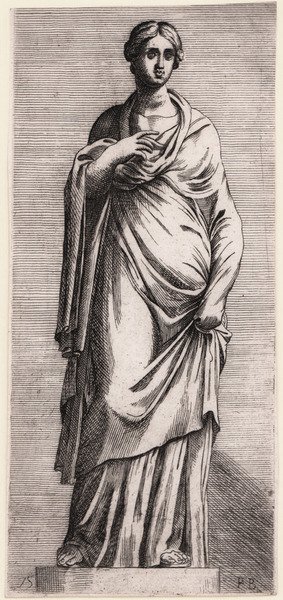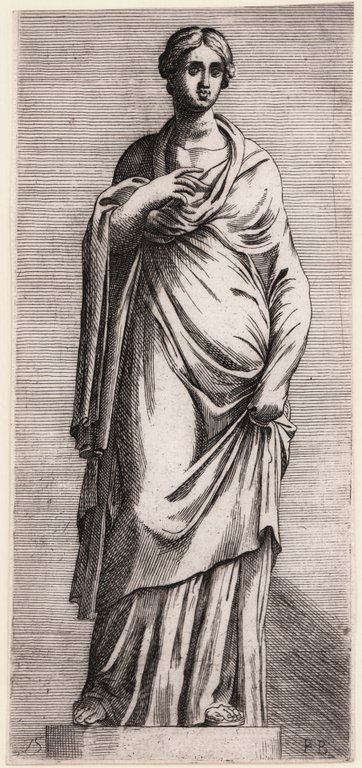Tavola tratta dal celebre ' Segmenta nobilium signorum et statuarum, quae temporis dentem invidium evasere Urbis aeternae ruinis erepta Typis aeneis ab ce commissa Perpetuae venerationis monumentum, ' Roma, De’ Rossi, 1653 o ante 1691. Formatosi come pittore a Roma negli anni 1620-25 nella bottega di Giovanni Lanfranco, François Perrier dettò il Borgognone (donde il monogramma FPB, con F e P sovrapposte) operò nei primi anni Trenta nell’orbita di Simon Vouet a Parigi, dove ebbe come allievi Le Brun e Dufresnoy. Di nuovo a Roma per un decennio a partire dal 1635, vi realizzò due raccolte di acqueforti dall’antico, i ' Segmenta ' (1638) e le ' Icones et segmenta illustrium e marmore tabularum quae Romae adhuc extant… stampate al suo rientro a Parigi (1645). I ' Segmenta ' riproducono in cento tavole un’ampia silloge di statue antiche “risparmiate dall’invidioso dente del Tempo” presenti nelle principali collezioni romane; le ' Icones ' invece i più noti bassorilievi, in cinquantacinque tavole. Entrambe le opere furono progettate con la fondamentale collaborazione di Giovan Pietro Bellori, massima autorità teorica e storico-artistica del classicismo seicentesco, e di altri eruditi, e appartengono al genere degli atlanti di antiquarie romane diffusi in tutta Europa a partire dalla metà del Cinquecento. L’atlante del Perrier, concepito anzitutto come una sorta di ‘accademia cartacea’ per gli artisti – quasi una versione a stampa di un taccuino di modelli – supportata da una vasta erudizione antiquaria, ebbe una notevole fortuna, testimoniata dalle numerose ristampe e derivazioni lungo tre secoli. Le discrepanze di alcune tavole rispetto alla prima edizione dei ' Segmenta ' (molte risultano in controparte, e si riscontrano diffuse difformità nei tratteggi) corrispondono non a prove di stampa, come ipotizzato da alcuni, ma alla riedizione presso la stamperia romana De’ Rossi, inventariata col titolo di ' Statue insigni di Roma intagliate in acquaforte, e copiate da Francesco Perrier libro in 103 quarti fogli imperiali nel 1677 ' (Le regole della bellezza ' 2012, pp. 9-10) e in seguito ' Indice 1797, p. 4), realizzata con una nuova serie di matrici (oggi conservate presso la Calcografia di Stato) nell’impossibilità di riuso di quelle originali, rientrate in Francia col Perrier. Bellissima prova, impressa su carta vergata coeva, rifilata al rame, in ottimo stato di conservazione. Bibliografia Lorenzo Fatticcioni, ' Le regole della bellezza. Saperi antiquari e teorie dell'Arte nei Segmenta nobilium Signorum et Statuarum di François Perrier, (2012); Gerardo de Simone, ' François Perrier, Segmenta nobilium signorum et statuarum, Roma, De' Rossi 1653; ' con disegni della bottega Baratta ' (2016). Plate taken from the famous ' Segmenta nobilium signorum et statuarum, quae temporis dentem invidium evasere Urbis aeternae ruinis erepta Typis aeneis ab ce commissa Perpetuae venerationis monumentum, Rome, De' Rossi, 1653 or ante 1691. Trained as a painter in Rome in the years 1620-25 in the workshop of Giovanni Lanfranco, François Perrier dictated the Borgognone (whence the monogram FPB, with F and P superimposed) operated in the early thirties in the orbit of Simon Vouet in Paris, where he had as students Le Brun and Dufresnoy. Back in Rome for a decade starting in 1635, he produced two collections of etchings from antiquity, the ' Segmenta ' (1638) and the ' Icones et segmenta illustrium e marmore tabularum quae Romae adhuc extant. printed on his return to Paris (1645). The ' Segmenta ' reproduce in one hundred plates a wide collection of ancient statues "spared by the envious tooth of Time" present in the main Roman collections; the Icones instead the most famous bas-reliefs, in fifty-five plates. Both works were designed with the fundamental collaboration of Giovan Pietro Bellori, the greatest theoretical and historical-artistic authority of seventeenth-century classicism, and other scholars, and belong to the genre of atlases of Roman antiquities spread throughout Europe from the mid-sixteenth century. Perrier's atlas, conceived above all as a sort of 'paper academy' for artists - almost a printed version of a notebook of models - supported by a vast antiquarian erudition, had a considerable fortune, testified by the numerous reprints and derivations over three centuries. The discrepancies of some plates with respect to the first edition of the ' Segmenta ' (many are in counterpart, and there are widespread differences in the hatching) correspond not to proofs, as assumed by some, but to the re-edition at the Roman printing house De 'Rossi, inventoried under the title of ' Statue insigni di Roma intagliate in acquaforte, e copiate da Francesco Perrier libro in 103 quarti fogli imperiali nel 1677 ' (cf, ' Le regole della bellezza ' 2012, pp. 9-10) and later in the ' Indice 1797, p. 4), made with a new set of plates (now preserved at the Rome Calcografia) in the impossibility of reusing the original ones, returned to France with Perrier. Beautiful proof, printed on contemporary laid paper, trimmed in copper, in excellent condition. Bibliografia Lorenzo Fatticcioni, ' Le regole della bellezza. Saperi antiquari e teorie dell'Arte nei Segmenta nobilium Signorum et Statuarum di François Perrier, (2012); Gerardo de Simone, ' François Perrier, Segmenta nobilium signorum et statuarum, Roma, De' Rossi 1653; ' con disegni della bottega Baratta ' (2016). Cfr.


Scopri come utilizzare
Scopri come utilizzare

